The Critical Role of Nursing Handover for Patient Safety
VerifiedAdded on 2022/11/12
|7
|1633
|319
Essay
AI Summary
This essay delves into the vital role of nursing handover in healthcare, emphasizing its impact on patient safety and quality of care. It highlights that effective communication during handover is crucial for preventing medical errors and ensuring comprehensive patient information transfer between nurses. The essay discusses how nursing handover broadens communication skills, enhances job satisfaction, and promotes smooth continuity in patient care. By involving patients and families in the handover process, trust is built, and patient-centered care is fostered. The analysis underscores the need for healthcare professionals and educators to prioritize and refine handover practices to optimize patient outcomes and cultivate high-performance teams. This resource is available for students on Desklib, which offers a wide range of study tools and solved assignments.

Running head: NURSING ASSIGNMENT 1
Nursing Assignment
Student’s Name
Institutional Affiliation
Nursing Assignment
Student’s Name
Institutional Affiliation
Paraphrase This Document
Need a fresh take? Get an instant paraphrase of this document with our AI Paraphraser
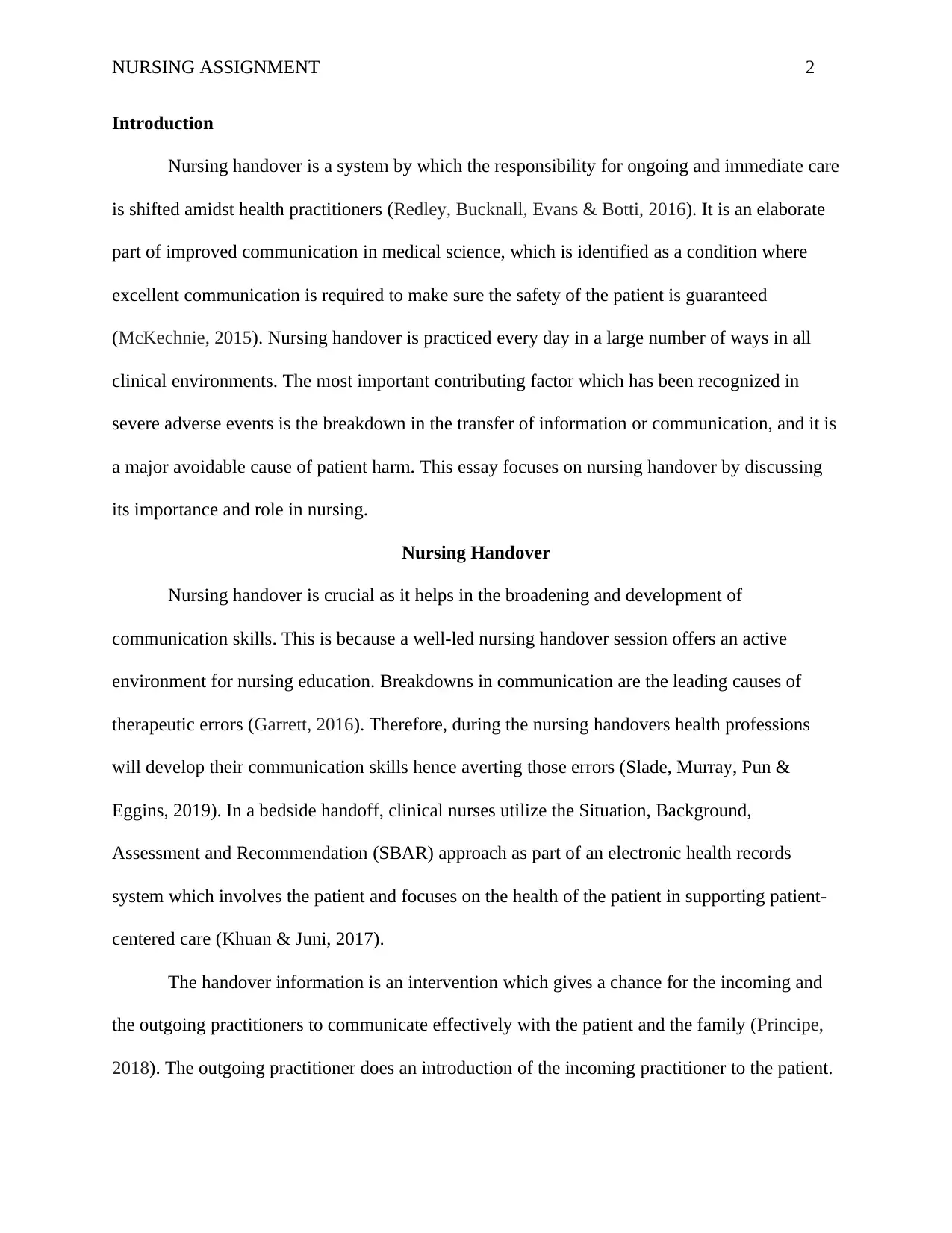
NURSING ASSIGNMENT 2
Introduction
Nursing handover is a system by which the responsibility for ongoing and immediate care
is shifted amidst health practitioners (Redley, Bucknall, Evans & Botti, 2016). It is an elaborate
part of improved communication in medical science, which is identified as a condition where
excellent communication is required to make sure the safety of the patient is guaranteed
(McKechnie, 2015). Nursing handover is practiced every day in a large number of ways in all
clinical environments. The most important contributing factor which has been recognized in
severe adverse events is the breakdown in the transfer of information or communication, and it is
a major avoidable cause of patient harm. This essay focuses on nursing handover by discussing
its importance and role in nursing.
Nursing Handover
Nursing handover is crucial as it helps in the broadening and development of
communication skills. This is because a well-led nursing handover session offers an active
environment for nursing education. Breakdowns in communication are the leading causes of
therapeutic errors (Garrett, 2016). Therefore, during the nursing handovers health professions
will develop their communication skills hence averting those errors (Slade, Murray, Pun &
Eggins, 2019). In a bedside handoff, clinical nurses utilize the Situation, Background,
Assessment and Recommendation (SBAR) approach as part of an electronic health records
system which involves the patient and focuses on the health of the patient in supporting patient-
centered care (Khuan & Juni, 2017).
The handover information is an intervention which gives a chance for the incoming and
the outgoing practitioners to communicate effectively with the patient and the family (Principe,
2018). The outgoing practitioner does an introduction of the incoming practitioner to the patient.
Introduction
Nursing handover is a system by which the responsibility for ongoing and immediate care
is shifted amidst health practitioners (Redley, Bucknall, Evans & Botti, 2016). It is an elaborate
part of improved communication in medical science, which is identified as a condition where
excellent communication is required to make sure the safety of the patient is guaranteed
(McKechnie, 2015). Nursing handover is practiced every day in a large number of ways in all
clinical environments. The most important contributing factor which has been recognized in
severe adverse events is the breakdown in the transfer of information or communication, and it is
a major avoidable cause of patient harm. This essay focuses on nursing handover by discussing
its importance and role in nursing.
Nursing Handover
Nursing handover is crucial as it helps in the broadening and development of
communication skills. This is because a well-led nursing handover session offers an active
environment for nursing education. Breakdowns in communication are the leading causes of
therapeutic errors (Garrett, 2016). Therefore, during the nursing handovers health professions
will develop their communication skills hence averting those errors (Slade, Murray, Pun &
Eggins, 2019). In a bedside handoff, clinical nurses utilize the Situation, Background,
Assessment and Recommendation (SBAR) approach as part of an electronic health records
system which involves the patient and focuses on the health of the patient in supporting patient-
centered care (Khuan & Juni, 2017).
The handover information is an intervention which gives a chance for the incoming and
the outgoing practitioners to communicate effectively with the patient and the family (Principe,
2018). The outgoing practitioner does an introduction of the incoming practitioner to the patient.
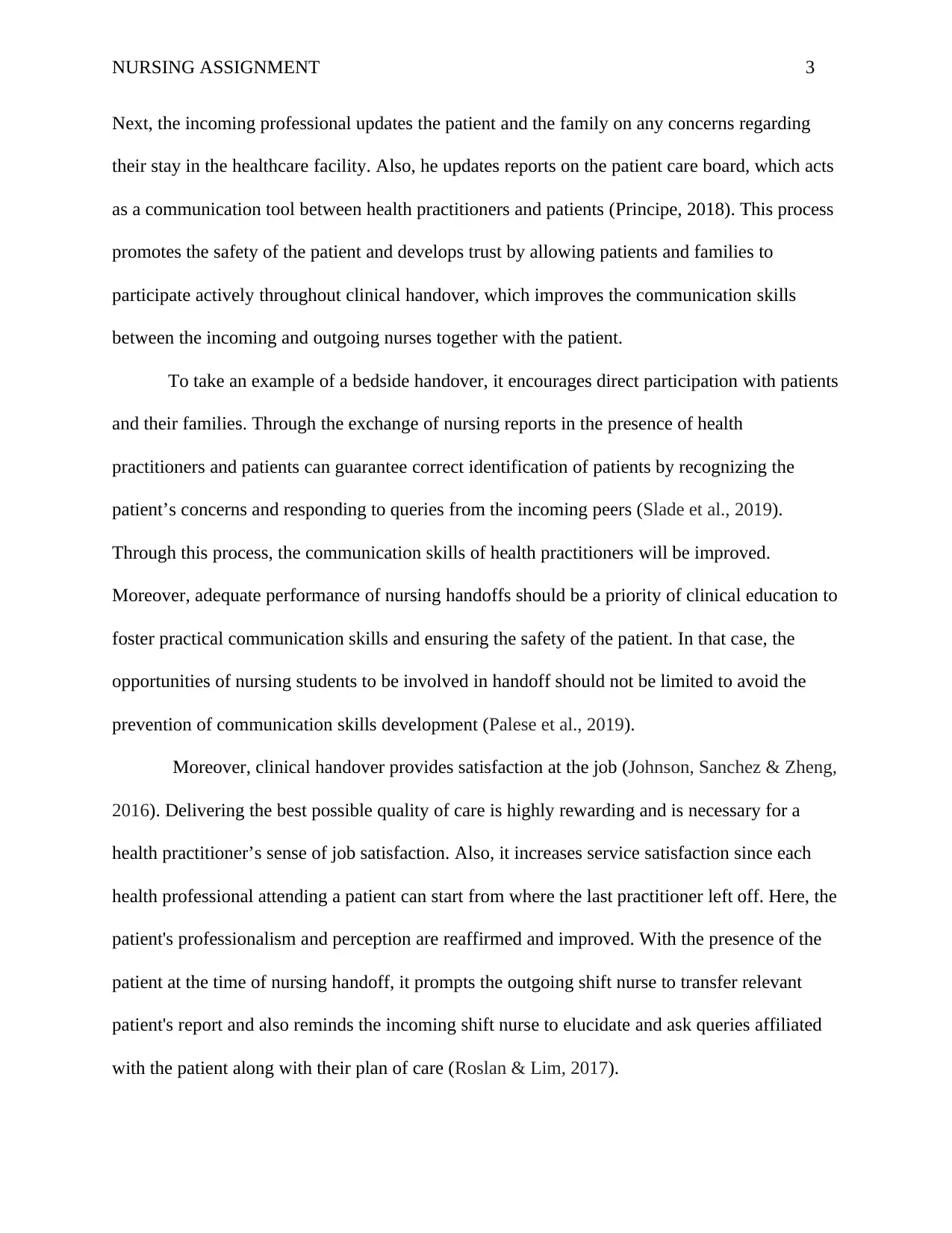
NURSING ASSIGNMENT 3
Next, the incoming professional updates the patient and the family on any concerns regarding
their stay in the healthcare facility. Also, he updates reports on the patient care board, which acts
as a communication tool between health practitioners and patients (Principe, 2018). This process
promotes the safety of the patient and develops trust by allowing patients and families to
participate actively throughout clinical handover, which improves the communication skills
between the incoming and outgoing nurses together with the patient.
To take an example of a bedside handover, it encourages direct participation with patients
and their families. Through the exchange of nursing reports in the presence of health
practitioners and patients can guarantee correct identification of patients by recognizing the
patient’s concerns and responding to queries from the incoming peers (Slade et al., 2019).
Through this process, the communication skills of health practitioners will be improved.
Moreover, adequate performance of nursing handoffs should be a priority of clinical education to
foster practical communication skills and ensuring the safety of the patient. In that case, the
opportunities of nursing students to be involved in handoff should not be limited to avoid the
prevention of communication skills development (Palese et al., 2019).
Moreover, clinical handover provides satisfaction at the job (Johnson, Sanchez & Zheng,
2016). Delivering the best possible quality of care is highly rewarding and is necessary for a
health practitioner’s sense of job satisfaction. Also, it increases service satisfaction since each
health professional attending a patient can start from where the last practitioner left off. Here, the
patient's professionalism and perception are reaffirmed and improved. With the presence of the
patient at the time of nursing handoff, it prompts the outgoing shift nurse to transfer relevant
patient's report and also reminds the incoming shift nurse to elucidate and ask queries affiliated
with the patient along with their plan of care (Roslan & Lim, 2017).
Next, the incoming professional updates the patient and the family on any concerns regarding
their stay in the healthcare facility. Also, he updates reports on the patient care board, which acts
as a communication tool between health practitioners and patients (Principe, 2018). This process
promotes the safety of the patient and develops trust by allowing patients and families to
participate actively throughout clinical handover, which improves the communication skills
between the incoming and outgoing nurses together with the patient.
To take an example of a bedside handover, it encourages direct participation with patients
and their families. Through the exchange of nursing reports in the presence of health
practitioners and patients can guarantee correct identification of patients by recognizing the
patient’s concerns and responding to queries from the incoming peers (Slade et al., 2019).
Through this process, the communication skills of health practitioners will be improved.
Moreover, adequate performance of nursing handoffs should be a priority of clinical education to
foster practical communication skills and ensuring the safety of the patient. In that case, the
opportunities of nursing students to be involved in handoff should not be limited to avoid the
prevention of communication skills development (Palese et al., 2019).
Moreover, clinical handover provides satisfaction at the job (Johnson, Sanchez & Zheng,
2016). Delivering the best possible quality of care is highly rewarding and is necessary for a
health practitioner’s sense of job satisfaction. Also, it increases service satisfaction since each
health professional attending a patient can start from where the last practitioner left off. Here, the
patient's professionalism and perception are reaffirmed and improved. With the presence of the
patient at the time of nursing handoff, it prompts the outgoing shift nurse to transfer relevant
patient's report and also reminds the incoming shift nurse to elucidate and ask queries affiliated
with the patient along with their plan of care (Roslan & Lim, 2017).
⊘ This is a preview!⊘
Do you want full access?
Subscribe today to unlock all pages.

Trusted by 1+ million students worldwide
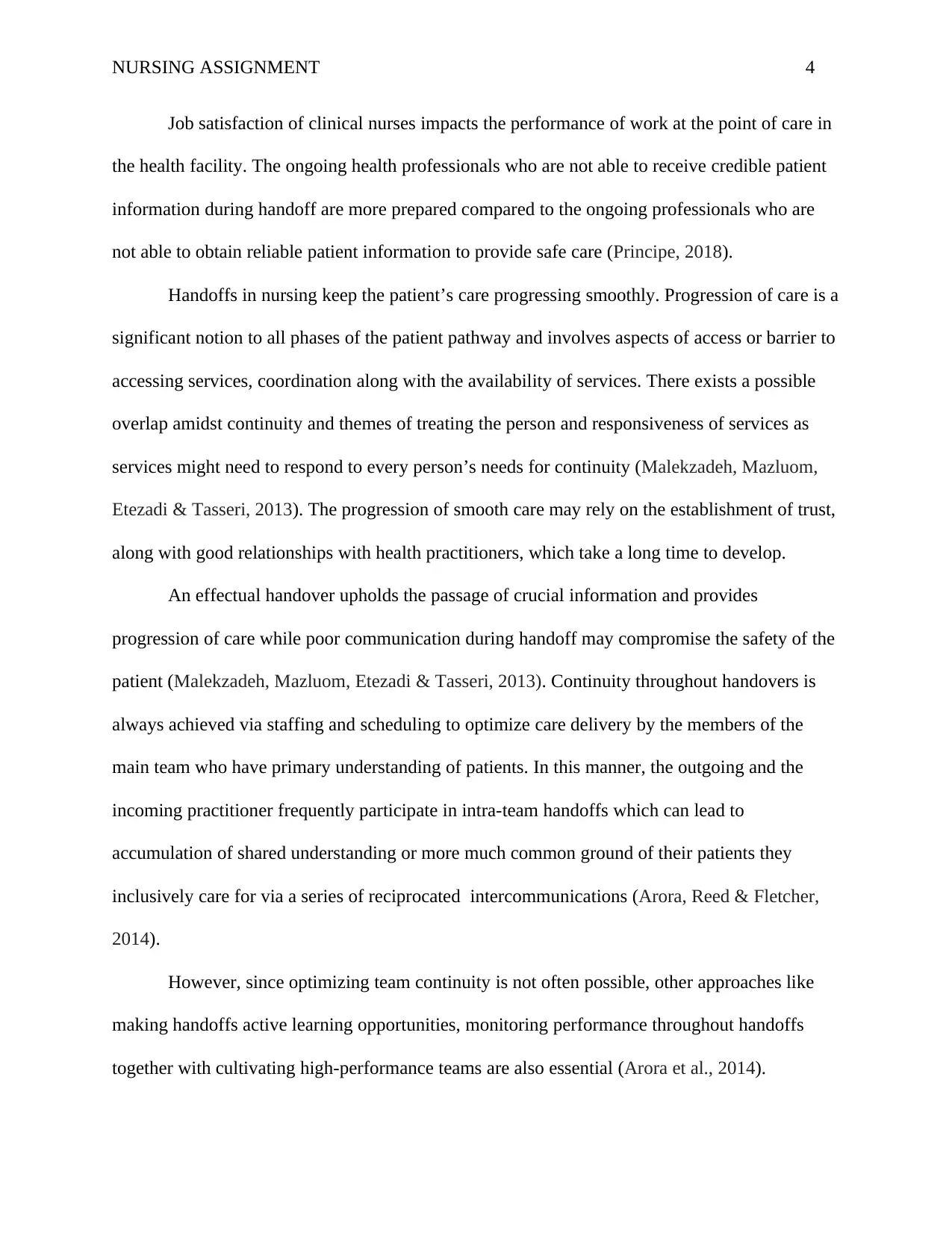
NURSING ASSIGNMENT 4
Job satisfaction of clinical nurses impacts the performance of work at the point of care in
the health facility. The ongoing health professionals who are not able to receive credible patient
information during handoff are more prepared compared to the ongoing professionals who are
not able to obtain reliable patient information to provide safe care (Principe, 2018).
Handoffs in nursing keep the patient’s care progressing smoothly. Progression of care is a
significant notion to all phases of the patient pathway and involves aspects of access or barrier to
accessing services, coordination along with the availability of services. There exists a possible
overlap amidst continuity and themes of treating the person and responsiveness of services as
services might need to respond to every person’s needs for continuity (Malekzadeh, Mazluom,
Etezadi & Tasseri, 2013). The progression of smooth care may rely on the establishment of trust,
along with good relationships with health practitioners, which take a long time to develop.
An effectual handover upholds the passage of crucial information and provides
progression of care while poor communication during handoff may compromise the safety of the
patient (Malekzadeh, Mazluom, Etezadi & Tasseri, 2013). Continuity throughout handovers is
always achieved via staffing and scheduling to optimize care delivery by the members of the
main team who have primary understanding of patients. In this manner, the outgoing and the
incoming practitioner frequently participate in intra-team handoffs which can lead to
accumulation of shared understanding or more much common ground of their patients they
inclusively care for via a series of reciprocated intercommunications (Arora, Reed & Fletcher,
2014).
However, since optimizing team continuity is not often possible, other approaches like
making handoffs active learning opportunities, monitoring performance throughout handoffs
together with cultivating high-performance teams are also essential (Arora et al., 2014).
Job satisfaction of clinical nurses impacts the performance of work at the point of care in
the health facility. The ongoing health professionals who are not able to receive credible patient
information during handoff are more prepared compared to the ongoing professionals who are
not able to obtain reliable patient information to provide safe care (Principe, 2018).
Handoffs in nursing keep the patient’s care progressing smoothly. Progression of care is a
significant notion to all phases of the patient pathway and involves aspects of access or barrier to
accessing services, coordination along with the availability of services. There exists a possible
overlap amidst continuity and themes of treating the person and responsiveness of services as
services might need to respond to every person’s needs for continuity (Malekzadeh, Mazluom,
Etezadi & Tasseri, 2013). The progression of smooth care may rely on the establishment of trust,
along with good relationships with health practitioners, which take a long time to develop.
An effectual handover upholds the passage of crucial information and provides
progression of care while poor communication during handoff may compromise the safety of the
patient (Malekzadeh, Mazluom, Etezadi & Tasseri, 2013). Continuity throughout handovers is
always achieved via staffing and scheduling to optimize care delivery by the members of the
main team who have primary understanding of patients. In this manner, the outgoing and the
incoming practitioner frequently participate in intra-team handoffs which can lead to
accumulation of shared understanding or more much common ground of their patients they
inclusively care for via a series of reciprocated intercommunications (Arora, Reed & Fletcher,
2014).
However, since optimizing team continuity is not often possible, other approaches like
making handoffs active learning opportunities, monitoring performance throughout handoffs
together with cultivating high-performance teams are also essential (Arora et al., 2014).
Paraphrase This Document
Need a fresh take? Get an instant paraphrase of this document with our AI Paraphraser
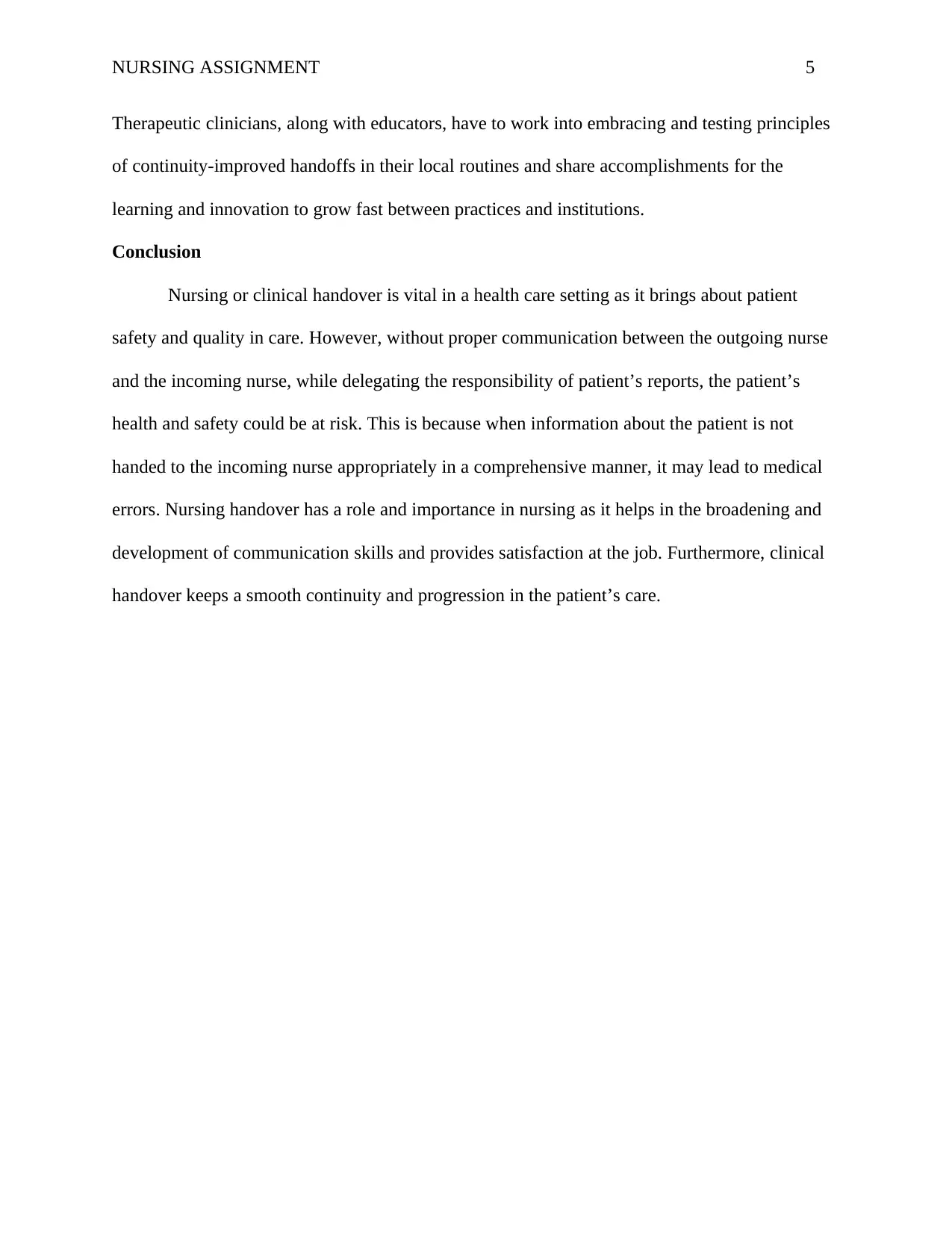
NURSING ASSIGNMENT 5
Therapeutic clinicians, along with educators, have to work into embracing and testing principles
of continuity-improved handoffs in their local routines and share accomplishments for the
learning and innovation to grow fast between practices and institutions.
Conclusion
Nursing or clinical handover is vital in a health care setting as it brings about patient
safety and quality in care. However, without proper communication between the outgoing nurse
and the incoming nurse, while delegating the responsibility of patient’s reports, the patient’s
health and safety could be at risk. This is because when information about the patient is not
handed to the incoming nurse appropriately in a comprehensive manner, it may lead to medical
errors. Nursing handover has a role and importance in nursing as it helps in the broadening and
development of communication skills and provides satisfaction at the job. Furthermore, clinical
handover keeps a smooth continuity and progression in the patient’s care.
Therapeutic clinicians, along with educators, have to work into embracing and testing principles
of continuity-improved handoffs in their local routines and share accomplishments for the
learning and innovation to grow fast between practices and institutions.
Conclusion
Nursing or clinical handover is vital in a health care setting as it brings about patient
safety and quality in care. However, without proper communication between the outgoing nurse
and the incoming nurse, while delegating the responsibility of patient’s reports, the patient’s
health and safety could be at risk. This is because when information about the patient is not
handed to the incoming nurse appropriately in a comprehensive manner, it may lead to medical
errors. Nursing handover has a role and importance in nursing as it helps in the broadening and
development of communication skills and provides satisfaction at the job. Furthermore, clinical
handover keeps a smooth continuity and progression in the patient’s care.
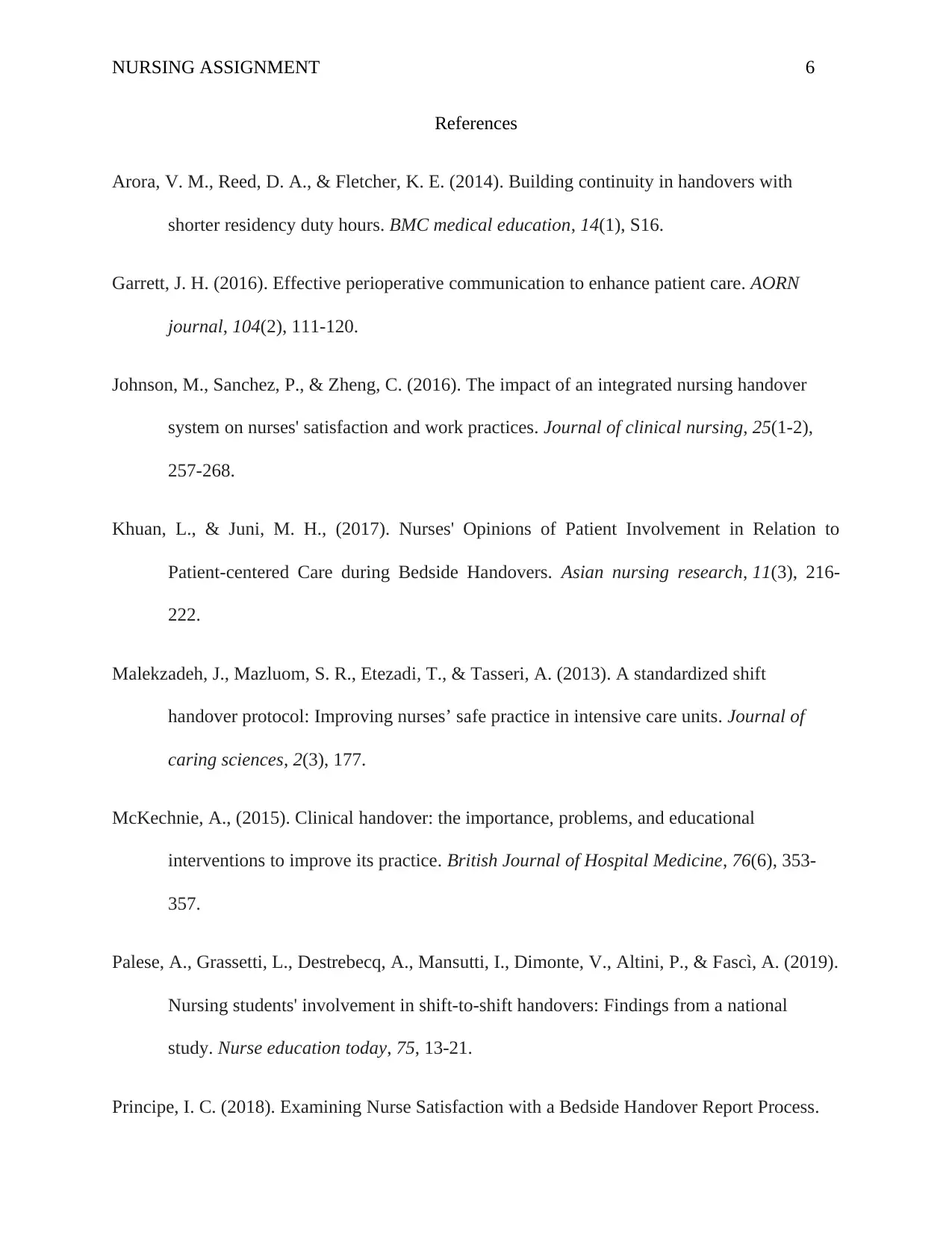
NURSING ASSIGNMENT 6
References
Arora, V. M., Reed, D. A., & Fletcher, K. E. (2014). Building continuity in handovers with
shorter residency duty hours. BMC medical education, 14(1), S16.
Garrett, J. H. (2016). Effective perioperative communication to enhance patient care. AORN
journal, 104(2), 111-120.
Johnson, M., Sanchez, P., & Zheng, C. (2016). The impact of an integrated nursing handover
system on nurses' satisfaction and work practices. Journal of clinical nursing, 25(1-2),
257-268.
Khuan, L., & Juni, M. H., (2017). Nurses' Opinions of Patient Involvement in Relation to
Patient-centered Care during Bedside Handovers. Asian nursing research, 11(3), 216-
222.
Malekzadeh, J., Mazluom, S. R., Etezadi, T., & Tasseri, A. (2013). A standardized shift
handover protocol: Improving nurses’ safe practice in intensive care units. Journal of
caring sciences, 2(3), 177.
McKechnie, A., (2015). Clinical handover: the importance, problems, and educational
interventions to improve its practice. British Journal of Hospital Medicine, 76(6), 353-
357.
Palese, A., Grassetti, L., Destrebecq, A., Mansutti, I., Dimonte, V., Altini, P., & Fascì, A. (2019).
Nursing students' involvement in shift-to-shift handovers: Findings from a national
study. Nurse education today, 75, 13-21.
Principe, I. C. (2018). Examining Nurse Satisfaction with a Bedside Handover Report Process.
References
Arora, V. M., Reed, D. A., & Fletcher, K. E. (2014). Building continuity in handovers with
shorter residency duty hours. BMC medical education, 14(1), S16.
Garrett, J. H. (2016). Effective perioperative communication to enhance patient care. AORN
journal, 104(2), 111-120.
Johnson, M., Sanchez, P., & Zheng, C. (2016). The impact of an integrated nursing handover
system on nurses' satisfaction and work practices. Journal of clinical nursing, 25(1-2),
257-268.
Khuan, L., & Juni, M. H., (2017). Nurses' Opinions of Patient Involvement in Relation to
Patient-centered Care during Bedside Handovers. Asian nursing research, 11(3), 216-
222.
Malekzadeh, J., Mazluom, S. R., Etezadi, T., & Tasseri, A. (2013). A standardized shift
handover protocol: Improving nurses’ safe practice in intensive care units. Journal of
caring sciences, 2(3), 177.
McKechnie, A., (2015). Clinical handover: the importance, problems, and educational
interventions to improve its practice. British Journal of Hospital Medicine, 76(6), 353-
357.
Palese, A., Grassetti, L., Destrebecq, A., Mansutti, I., Dimonte, V., Altini, P., & Fascì, A. (2019).
Nursing students' involvement in shift-to-shift handovers: Findings from a national
study. Nurse education today, 75, 13-21.
Principe, I. C. (2018). Examining Nurse Satisfaction with a Bedside Handover Report Process.
⊘ This is a preview!⊘
Do you want full access?
Subscribe today to unlock all pages.

Trusted by 1+ million students worldwide
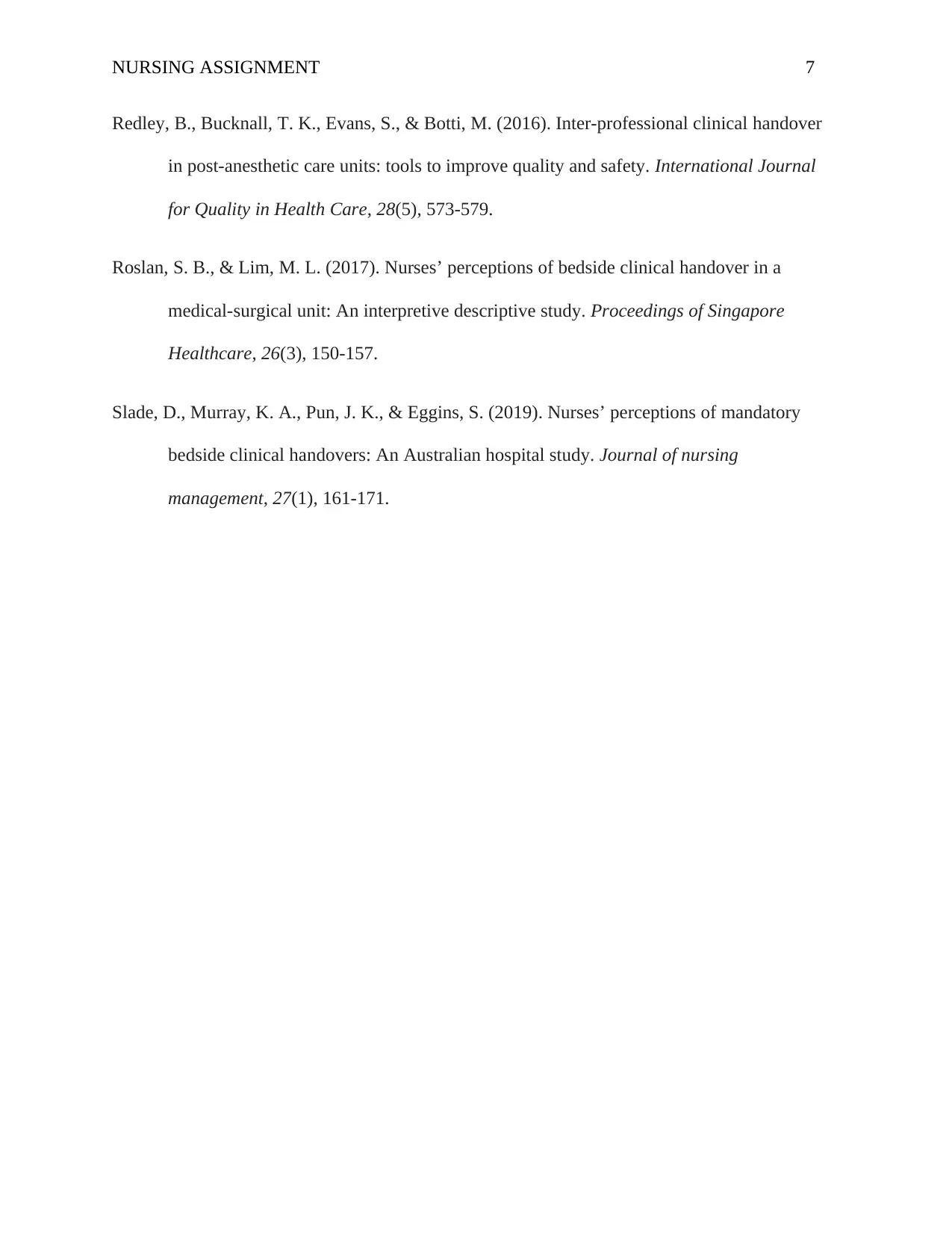
NURSING ASSIGNMENT 7
Redley, B., Bucknall, T. K., Evans, S., & Botti, M. (2016). Inter-professional clinical handover
in post-anesthetic care units: tools to improve quality and safety. International Journal
for Quality in Health Care, 28(5), 573-579.
Roslan, S. B., & Lim, M. L. (2017). Nurses’ perceptions of bedside clinical handover in a
medical-surgical unit: An interpretive descriptive study. Proceedings of Singapore
Healthcare, 26(3), 150-157.
Slade, D., Murray, K. A., Pun, J. K., & Eggins, S. (2019). Nurses’ perceptions of mandatory
bedside clinical handovers: An Australian hospital study. Journal of nursing
management, 27(1), 161-171.
Redley, B., Bucknall, T. K., Evans, S., & Botti, M. (2016). Inter-professional clinical handover
in post-anesthetic care units: tools to improve quality and safety. International Journal
for Quality in Health Care, 28(5), 573-579.
Roslan, S. B., & Lim, M. L. (2017). Nurses’ perceptions of bedside clinical handover in a
medical-surgical unit: An interpretive descriptive study. Proceedings of Singapore
Healthcare, 26(3), 150-157.
Slade, D., Murray, K. A., Pun, J. K., & Eggins, S. (2019). Nurses’ perceptions of mandatory
bedside clinical handovers: An Australian hospital study. Journal of nursing
management, 27(1), 161-171.
1 out of 7
Related Documents
Your All-in-One AI-Powered Toolkit for Academic Success.
+13062052269
info@desklib.com
Available 24*7 on WhatsApp / Email
![[object Object]](/_next/static/media/star-bottom.7253800d.svg)
Unlock your academic potential
Copyright © 2020–2025 A2Z Services. All Rights Reserved. Developed and managed by ZUCOL.





